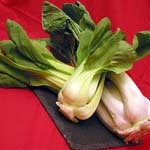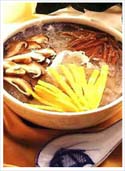|
The phrase is a testament to the popularity
of Chinese food around the world. Food is an important part of
daily life for Chinese people. Chinese not only enjoy eating but
believe eating good food can bring harmony and closeness to the
family and relationships.
 Shopping daily for fresh food is essential
for all Chinese cooking. Unlike the fast food society of the
U.S., the Chinese select live seafood, fresh meats and seasonal
fruits and vegetables from the local market to ensure freshness.
This means swimming fish, snappy crabs, and squawking chickens.
Even prepared foods such as dim sum or BBQ duck for to go orders
must gleam, glisten, and steam as if just taken out of the oven. Shopping daily for fresh food is essential
for all Chinese cooking. Unlike the fast food society of the
U.S., the Chinese select live seafood, fresh meats and seasonal
fruits and vegetables from the local market to ensure freshness.
This means swimming fish, snappy crabs, and squawking chickens.
Even prepared foods such as dim sum or BBQ duck for to go orders
must gleam, glisten, and steam as if just taken out of the oven.
Chinese people in general are not as
concerned about nutrition as Western culture. They are more
concerned with the food's texture, flavor, color, and aroma.
These are the crucial points for good Chinese cooking. Chinese
daily meals consist of four food groups: grains, vegetables,
fruit, and meat. Because of lactose intolerance, Chinese do not
consume large amounts of dairy products. Instead, Chinese
substitute these with soymilk and tofu, which also contain large
amounts of protein and calcium. Vegetables, fruits, and meats
are usually fresh. Some exceptions include preserved vegetables
such as snow cabbage or mustard greens, preserved eggs, aka
 "thousand year old eggs" or salted and dried fish. Other
exceptions include snack items such as beef jerky, cuttlefish
jerky, sweet and sour preserved plums, or dehydrated mango
slices. Canned or frozen foods are seldom eaten. Western
desserts such as cookies, cakes, pies, and ice cream are eaten
only on special occasions such as birthdays and weddings. After
dinner, families usually eat seasonal fruit as dessert. Chinese
desserts such as red bean soup, sweet white lotus's seed soup,
or steam papaya soup are served every so often as a special
treat on a hot summer's night. "thousand year old eggs" or salted and dried fish. Other
exceptions include snack items such as beef jerky, cuttlefish
jerky, sweet and sour preserved plums, or dehydrated mango
slices. Canned or frozen foods are seldom eaten. Western
desserts such as cookies, cakes, pies, and ice cream are eaten
only on special occasions such as birthdays and weddings. After
dinner, families usually eat seasonal fruit as dessert. Chinese
desserts such as red bean soup, sweet white lotus's seed soup,
or steam papaya soup are served every so often as a special
treat on a hot summer's night.
Ethnic Chinese cooking does not involve a
lot of deep fried cooking. The reason most of the Chinese
restaurants in America have deep-fried dishes such as sweet and
sour pork, almond fried Chicken, and deep-fried shrimp is to
promote business and to please western tastes. This clearly
reflects why there are more overweight and high blood pressure
concerns in Western culture than there are in Chinese culture.
"Yi xing bu xing"
 Chinese hardly waste any section of the
animal and have found ways to cook nearly every part. Chinese
culture believes that "yi xing bu xing," which means by using
any shape or part of the animal the same part of the human body
can be replenished and strengthened. For example, shark fin soup
and bird nest soup (bird's saliva) is served to replenish
strength and increase appetite, crocodile meat strengthens the
bronchia, dehydrated tiger testicle increases stamina for men,
while monkey brains add wisdom. These foods are considered to be
delicacies and tonics. Shark fin soup or bird nest soup is often
served at special occasions such as at a Chinese banquet dinner.
Other items are rarely prepared. Chinese hardly waste any section of the
animal and have found ways to cook nearly every part. Chinese
culture believes that "yi xing bu xing," which means by using
any shape or part of the animal the same part of the human body
can be replenished and strengthened. For example, shark fin soup
and bird nest soup (bird's saliva) is served to replenish
strength and increase appetite, crocodile meat strengthens the
bronchia, dehydrated tiger testicle increases stamina for men,
while monkey brains add wisdom. These foods are considered to be
delicacies and tonics. Shark fin soup or bird nest soup is often
served at special occasions such as at a Chinese banquet dinner.
Other items are rarely prepared.
|



